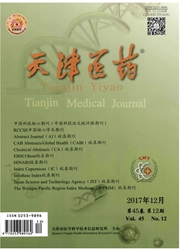

 中文摘要:
中文摘要:
目的探讨老老年高血压病患者并发阵发性房颤(PAF)的危险因素。方法206例老老年高血压病患者按心电图及病史资料分为PAF组66例和窦性心律(SR)组140例,记录年龄、性别、体质指数(BMI)、使用血管紧张素转化酶抑制剂(ACEI)、血管紧张素Ⅱ受体拮抗剂(ARB)及他汀类药物史、24h动态血压监测(ambulatoryBPmeasurements,ABPM)结果、心脏超声指标、脉搏波波速(pulsewavevelocity,PWV)、血脂、肾功能等,对相关危险因素进行Logistic回归分析。结果PAF组年龄、左心房前后径(LAD)、左心室质量指数(LVMI)、PWV均高于SR组[分别为(88.92±3.42)岁vs.(86.36±4.67)岁,(39.00±6.66)mmvs.(33.54±7.77)mm,(132.49±14.83)gvs.(119.00±11.35)g,(13.45±4.85)m/svs.(9.89±2.74)m/s],PAF组三酰甘油(TG)、血压平滑指数(SI)较SR组低[分别为(1.33±0.91)mmol/Lvs.(1.95±1.29)mmol/L,0.75±0.06vs.0.79±0.04]。二分类Logistic回归分析显示SI减低,LAD、LVMI增大、PWV增快皆是老老年高血压病患者并发PAF的危险因素。结论血压不平稳、左心房增大、左心室肥厚、动脉硬化皆是老老年高血压病患者并发PAF的危险因素。
 英文摘要:
英文摘要:
Objective To analyze the risk factors of paroxysmal atrial fibrillation (PAF) in very olderly hypertensive patients. Methods According to the electrocardiograph (ECG) and history data, two hundred and six older oldhypertensive patients were divided into PAF group (n=66) and sinus rhythm (SR) group (n=140). Data of age, gender, body mass index (BMI), the use of angiotension-converting enzyme inhibitors (ACEIs), angiotensin receptor blockers (ARBs) and statin drug history, 24-hour ambulatory blood pressure monitoring (ABPM), echocardiography, pulse wave velocity (PWV),blood lipid profile and renal function were recorded in two groups. Logistic regression analyses of the relevant factors were compared between groups. Results Data of age, the diameter of the left atrium (LAD), the 1eft ventricular mass index (LVMI) and the PWV were significantly higher in PAF group than those of SR group [(88.92±3.42) years old vs. (86.36±4.67) years old, (39.00±6.66) mm vs. (33.54±7.77) mm, (132.49±14.83) g vs. (119.00±11.35) g, (13.45±4.85) m/s vs. (9.89±2.74) m/s,respectively]. Values of three acyl glycerin (TG), blood pressure smoothing index (SI) were lower in PAF group than those of SR group [(1.33±0.91) mmol/L vs. (1.95±1.29) mmol/L, 0.75±0.06 vs. 0.79±0.04, respectively]. Results of two classification Logistic regression analyses showed that the reduced SI, the enlarged LAD and LVMI and the increased PWV were the risk factors of PAF in very olderly hypertensive patients. Conclusion Unstable blood pressure, left atrial enlargement, left ventricular hypertrophy and arterial stiffness are the risk factors of PAF in very olderly hypertensive patients.
 同期刊论文项目
同期刊论文项目
 同项目期刊论文
同项目期刊论文
 期刊信息
期刊信息
